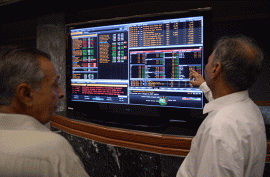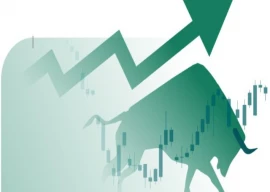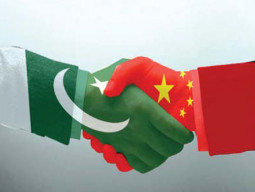
Provisional official results show that gross domestic product (GDP) growth rate for fiscal year 2018-19 was almost half of the annual target of 6.2% because of negligible growth in the agricultural and industrial sectors.
The slow pace of economic growth coupled with currency devaluation has caused the size of the economy -- in the US dollar terms -- to slip to around $280 billion from $313 billion at the end of the Pakistan Muslim League-Nawaz (PML-N) government's term.
GDP -- the monetary value of all goods and services produced in a year -- is projected to have grown at a rate of 3.29% during fiscal year 2018-19 ending on June 30, according to the National Accounts Committee (NAC).
The growth has come largely from the services sector, which is less job-intensive. It contributed 87% to the total national output for the outgoing fiscal year.
Further rupee fall, interest rate hike expected
The NAC also revised the economic growth rate upward for the last year of the PML-N government from 5.2% to 5.53%.
In February this year, the PTI government cut the GDP growth rate from 5.8% to 5.2% for the fiscal year 2017-18 claiming that the PML-N government overstated the growth rate. But now, its claim has proven wrong.
Planning Secretary Zafar Hasan chaired the 101th meeting of the NAC that endorsed the provisional economic growth rate figure on the basis of data received from the federal and provincial governments.
The figure is provisional and subject to variations once the final results are available at the end of the fiscal year.
The 3.29% growth rate is the lowest in nine years. In 2010-11, the economy had grown at a rate of 3.6%. The 3.3% economic growth rate depicts the challenges that the PTI government faced in its first year in power. Almost every sector has witnessed negative growth. The provisional growth rate in the first year of the PTI is almost half the pace needed to absorb the youth bulge.
The government's indecisiveness and inconsistent economic policies severely damaged the economy, leading to the unceremonious removal of former finance minister Asad Umar.
Challenge for Pakistan is to sustain growth levels: ADB
As Pakistan is set to enter an International Monetary Fund (IMF) programme, the prospects for higher economic growth in the next two years are also very low.
The 3.3% growth rate is largely in line with the projections of international financial institutions that had predicted a 2.9% to 3.9% GDP growth rate. The IMF had projected the lowest rate of 2.9%.
About 87% growth came from the services sector and its share in the total size of the economy has increased to 60%.
The agricultural sector contributed only 5% to the annual national output while its weight in the GDP remained at 19.27%.
The industrial sector's contribution to the total GDP growth was only 9% and its weight in the size of the economy was 20.8%.
The government missed the growth targets set for the services, agricultural and industrial sectors with a wide margin. The sub-sectors of electricity generation, housing services, general government services and other private services relatively performed better.
The electricity generation and gas distribution was the only sector that outperformed and its growth stood at 40.5% against the 10% target set for the outgoing fiscal year.
Adviser to the Prime Minister on Finance Dr Abdul Hafeez Shaikh will formally announce a provisional growth rate of 3.3% on June 10 with the release of the Economic Survey of Pakistan 2018-19.
IMF puts country’s growth rate at 2.5%
Agriculture
After witnessing a 4% growth rate in the last fiscal year, the agricultural sector only grew 0.85% this time, as the government missed all its sub-sector targets except livestock.
The government had set a target of 3.8% growth in the agricultural sector for this fiscal year.
The production of major crops contracted by 4.4% and other crops also saw a negative growth of 6.6%. Cotton ginning grew at a pace of less than 2%, according to the NAC.
Livestock posted a 4% growth rate and the forestry sector grew by 6.5% but could not meet its target. The fishing sector grew by only 0.8% against the 1.8% target.
Cotton production declined 17.5%. The production of rice and sugarcane also fell by 3.3% and 19.4% respectively.
The output of wheat grew only 0.5% to slightly over 25 million metric tonnes.
The production of maize showed a growth of nearly 7%.
Industries
The government missed all its targets set for the industrial sector except for electricity generation and small-scale industries. Against a target of 7.6%, the output in the industrial sector stood at only 1.4%. The output of large-scale manufacturing contracted 0.3% while small-scale manufacturing grew to 8.2%.
The slaughtering sub-sector grew at a pace of 3.5%, electricity generation and distribution by 40.5% against the 10% target and mining and quarrying sub-sector registered a negative growth of 2% against the target of 3.6%. The construction sector also posted a negative growth of 7.5%.
Services
The services sector, which accounts for 60% of the size of the economy, grew by 4.7% against the target of 6.5%. Aided by heavy government borrowing and an increase in the money supply, the financial services sector and government services posted a decent growth.
The wholesale and retail trade posted 3.1% growth against the target of 7.8%. The transport, storage and communication sub-sector saw a 3.4% growth rate. The finance and insurance sector witnessed 5.1% growth against the target of 7.5%.


















COMMENTS
Comments are moderated and generally will be posted if they are on-topic and not abusive.
For more information, please see our Comments FAQ